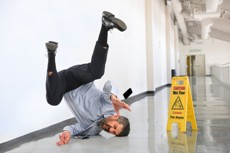
When you own a business or property, there is always the potential that someone could have a slip and fall accident on your premises. The reason they are called “accidents” is because they happen accidentally. Unfortunately, that doesn’t always mean that you can’t be held liable if someone falls and is injured. The owner of any property has an obligation to ensure that the conditions are safe for people to enter. If you fail to take the proper care to ensure that there aren’t conditions that could hurt people, then it is your legal obligation to pay for any injuries that result.
The most common types of slip and fall injuries that happen indoors are highly preventable if you know what to look for. These are the most common slip and fall injuries, and what you can do to avoid being held liable for someone else’s accidental fall.
Floors
According to a slip & fall lawyer, one of the most prevalent slip and fall injuries happens on floors that are not maintained properly. If you leave floors wet and slippery, then you can be held liable if someone hurts themselves. The most common accidents happen if an owner:
- Fails to warn people of danger in the form of signs or verbally telling them if the floors are being washed and are still wet — or just damp — creating a slick surface
- Fails to close off or provide barriers to close off any areas of the floor that are damp or wet and slick
- Uses an excessive amount of polish or wax that makes floors slippery
- Applies polish or wax unevenly
- Only partially treats floors and creates a difference in walking from one area of the floor to another
- Applies any type of floor treatment that makes the floor either sticky or slick
- Fails to use floor polishes or wax that don’t have non-skid ingredients when it is required to clean, polish or wax them
Property owners are also responsible for things like carpeting, floor mats, and area rugs. If they are bunched up or uneven, they could cause a potential danger. To ensure that no one has a slip and fall injury, always inspect carpeting to ensure that there aren’t any:
- Worn, broken, torn, or bulging areas of carpeted floors
- Mats or rugs that have curled-up edges, or any heavily worn spots or edges protruding that can be tripped over
- Items sticking up from the carpeting that can cause someone to trip
Stairs
Stair treads are notorious for becoming worn in places, like the edges, that can predispose people to trip and fall if used frequently. If a property owner knows of a potential danger and does nothing to fix it, then they would be held liable if someone falls and hurts themselves. These are common things that cause injury on stairs that should be addressed immediately:
- Having stairs that are highly worn or rounded
- Stairs littered with debris, dirt, sticky things, or anything else that someone can trip on
- Recently waxed or polished treads or cleaning materials used that don’t have “nonstick” ingredients in them
- A missing or broken handrail
Elevators and escalators
For bigger buildings and business properties, escalators and elevators can pose an additional risk for slip and fall injuries. Because their sole intention is to transport people, they may require an additional standard of care when it comes to premises liability. Things that commonly cause injuries with escalators and elevators are when they have jerky movements or the machinery isn’t working correctly. Another hazard is getting limbs, fingers or other appendages stuck in an escalator or in the doors of an elevator due to not having the proper safety mechanism in place to prevent the doors from closing if there is an object in the way.
If someone slips and falls while on your property, then you may be held liable due to slip and fall laws. The good news is that most accidents are highly preventable with some care, concern, and attention to detail on your part. Inspect often and address any potential hazards immediately, and you can decrease the likelihood that you will ever be held liable for a slip and fall accident.






